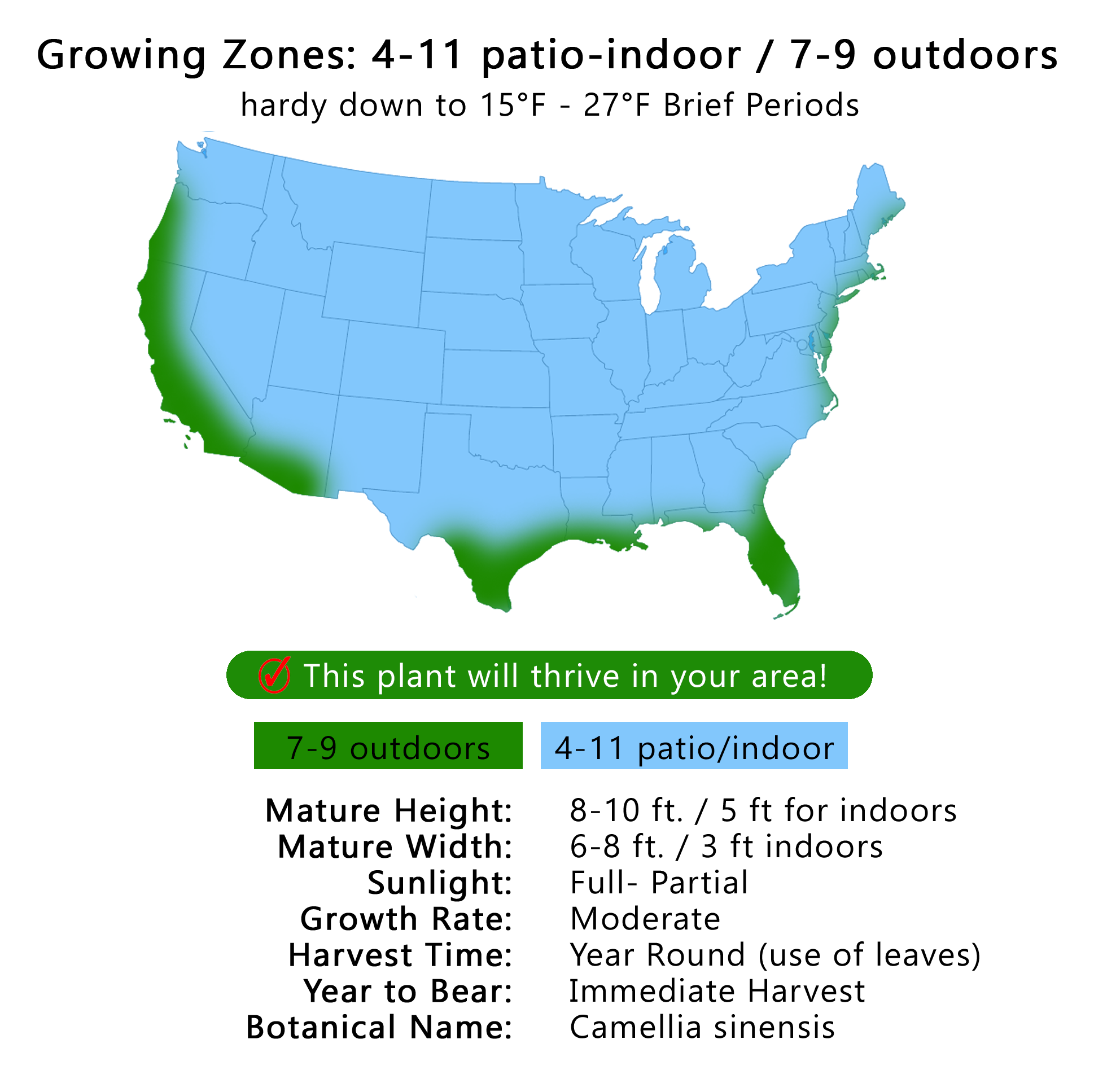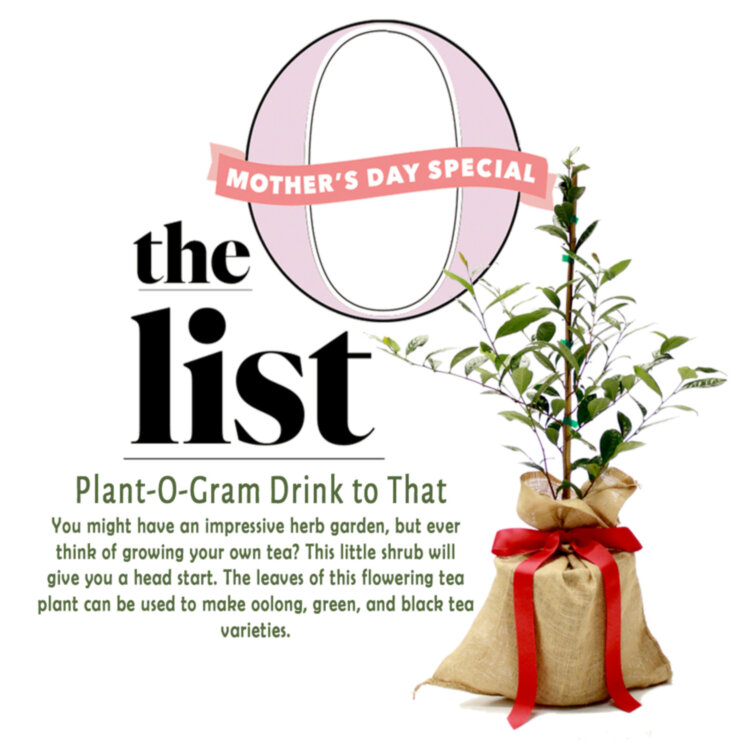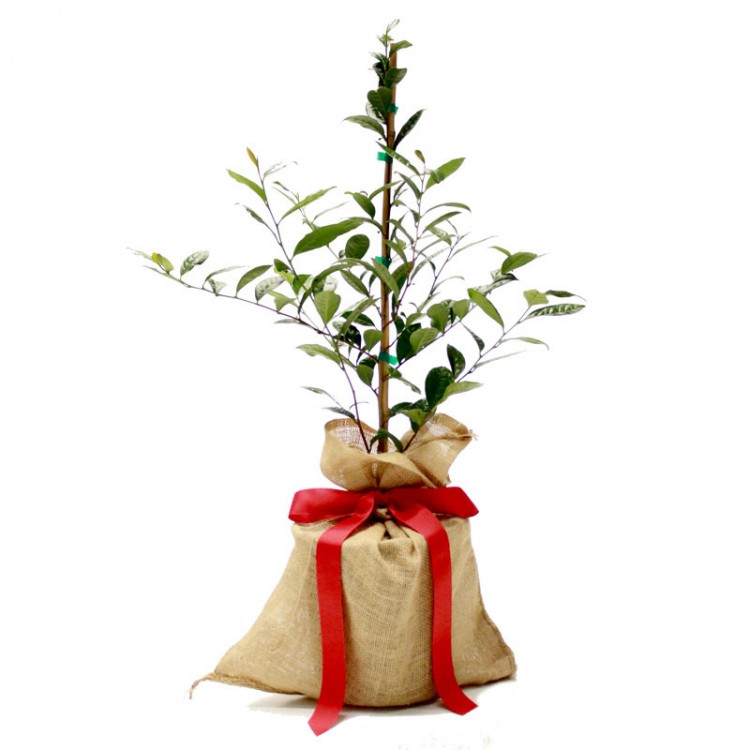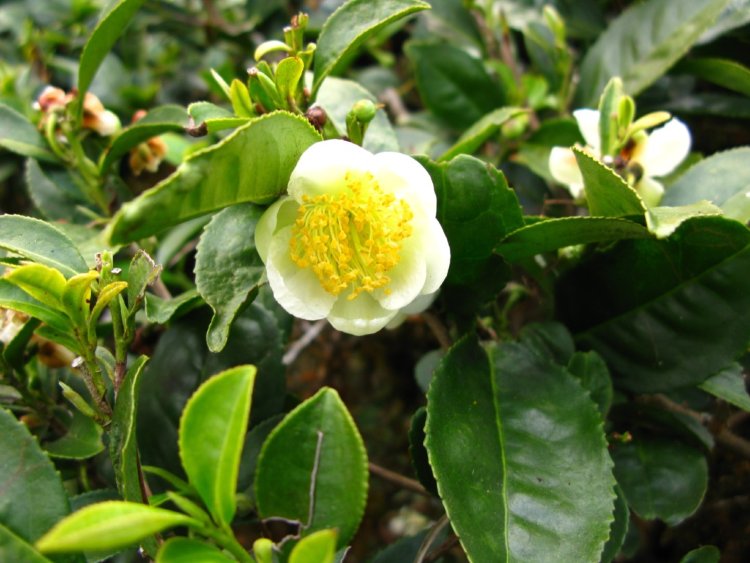- Overview

Common name: Tea Plant Large Leaf
Botanical name: Camellia sinensis Family: Theaceae
Origin: South and Southeast Asia Tea Plant Large Leaf Variety in a 3 Gallon Container. The Tea plant is a small shrub about 1-2 meters in height, though it will grow taller if you don't prune it. In the fall, your tea shrub will flower with small white blossoms that have a delightful scent. These plants are often grown as ornamentals. For planting, Camellia sinensis likes well-drained and sandy soil that is on the acidic side. If you are going to grow your tea in a container, add some sphagnum moss to the potting mix. The Leaves of this plant are used to make teas including Green Tea, Oolong Tea and Black Tea. Seen on the
 Learn how you can create a DIY Tea Garden.
Learn how you can create a DIY Tea Garden. 
Tea History
Description
Uses
Folk Medicine
Chemistry
Cultivation
Harvesting
Yields and Economics
Germplasm
DistributionSmall evergreen tree to 16 m tall, usually pruned back to shrubs in cultivation, with strong taproot giving rise to a surface mat of feeders with endotrophic mycorrhizae; leaves alternate, exstipulate, lanceolate to obovate, up to 30 (usually 4-15) cm long, 2-5 (7-12) cm broad, pubescent, sometimes becoming glabrous, serrate, acute or acuminate; flowers 1-3, in axillary or subterminal cymes, deflexed, 2-5 cm broad, aromatic, white or pinkish, actinomorphic, sepals and petals 5-7, pedicels 5-15 mm long; stamens numerous; ovary 3-5-carpellate, each carpel 4-6-ovulate; capsules depressed-globose, brownish, lobate, to 2 cm broad, valvate, with 1-3 subglobose seeds in each lobe; approximately 500 seeds per kg. Fl. Oct.-Dec. in Japan.
Making Your Own Tea
Once your tea plant is growing well, you'll need to harvest and process your tea leaves. From your plant, you can make black, green or oolong tea.
Green Tea- Pluck the very youngest leaves and leaf buds.
- Blot the leaves dry, and let dry in the shade for a few hours.
- Steam the leaves (like you would vegetables) on your stove for about a minute.
- For a different flavour, try roasting them in a skillet for 2 minutes instead of steaming.
- Spread the leaves on a baking sheet and dry in the oven at 250F for 20 minutes.
- Store the dried tea leaves in an air-tight container
Oolong Tea
- Pluck the very youngest leaves and leaf buds.
- Spread them out on a towel under the sun and let them wilt for about 45 minutes.
- Bring your leaves inside and let them sit at room temperature for a few hours.
- Make sure to stir the leaves up every hour.
- The edges of the leaves will start to turn red as they begin to dry.
- Spread the leaves on a baking sheet and dry in the oven at 250F for 20 minutes.
- Store the dried tea leaves in an air-tight container.
Black Tea
- Pluck the very youngest leaves and leaf buds.
- Roll the leaves between your hands, and crush them until the leaves start to darken and turn red.
- Spread them out on a tray, and leave them in a cool location for 2-3 days.
- Dry them in the oven at 250F for about 20 minutes.
- Store in an air-tight container.
Once you get the hang of it, try experimenting with different drying times to get different tastes. Mix your teas with jasmine or hibiscus flowers for a lovely summer tea right from your garden.
Dried and cured leaves widely used for a beverage, which has a stimulant effect due to caffeine. Used for this purpose in China for nearly 3,000 years. Chasei is a tea extract; powdered tea (Teu-cha) a ceremonial tea. Green tea is made from leaves steamed and dried, while black tea leaves are withered, rolled, fermented and dried. Steam distillation of black tea yields an essential oil. Tea extract is used as a flavor in alcoholic beverages, frozen dairy desserts, candy, baked goods, gelatins, and puddings (Leung, 1980). Air-dry tea seed yields a clear golden-yellow oil resembling sasanqua oil, but the seed cake, containing saponin, is not suitable for fodder. Refined teaseed oil, made by removing the free fatty acids with caustic soda, then bleaching the oil with Fuller's earth and a sprinkling of bone black, makes an oil suitable for use in manufacture of sanctuary or signal oil for burning purposes, and in all respects is considered a favorable substitute for rapeseed, olive, or lard oils. The oil is different from cottonseed, corn, or sesame oils in that it is a non-drying oil and is not subject to oxidation changes, thus making it very suitable for use in the textile industry; it remains liquid below -18deg.C. Tea is a potential source of food colors (black, green, orange, yellow, etc.).
The infusion, once recommended in China as a cancer cure, contains some tannin, suspected of being carcinogenic. Chinese regard tea as antitoxic, diuretic, expectorant, stimulant, and stomachic (Leung, 1980). Tea, considered astringent, stimulant, and acts as a nervine or nerve sedative, frequently relieving headaches. It may also cause unpleasant nerve and digestive disturbances. The infusion is also recommended for neuralgic headaches. According to Leung, tea is reportedly effective in clinical treatment of amebic dysentery, bacterial dysentery, gastroenteritis, and hepatitis. It has also been reported to have antiatherosclerotic effects and vitamin P activity (Leung, 1980). Teabags have been poulticed onto baggy or tired eyes, compressed onto headache, or used to bathe sunburn. Duke and Wain (1981) report that the plant has a folk reputation as analgesic, antidotal, astringent, cardiotonic, carminative, CNS-stimulant, demulcent, deobstruent, digestive, diuretic, expectorant, lactagogue, narcotic, nervine, refrigerant, stimulant, and stomachic; used for bruises, burns, cancer, cold, dogbite, dropsy, dysentery, epilepsy, eruptions, fever, headache, hemoptysis, hemorrhage, malaria, ophthalmia, smallpox, sores, toxemia, tumors, and wounds (Duke and Wain, 1981).
Fresh leaves from Assam contain 22.2% polyphenols, 17.2% protein, 4.3% caffeine, 27.0% crude fiber, 0.5% starch, 3.5% reducing sugars, 6.5% pectins, 2.0% ether extract and 5.6% ash. Per 100 g, the leaf is reported to contain 293 calories, 8.0 g H2O, 24.5 g protein, 2.8 g fat, 58.8 g total carbohydrate, 8.7 g fiber, 5.9 g ash, 327 mg Ca, 313 mg P, 24.3 mg Fe, 50 mg Na, 2700 ug beta-carotene equivalent, 0.07 mg thiamine, 0.8 mg riboflavin, 7.6 mg niacin, and 9 mg ascorbic acid. Another report tallies 300 calories, 8.0 g H2O, 28.3 g protein, 4.8 g fat, 53.6 g total carbohydrate, 9.6 g fiber, 5.6 g ash, 245 mg Ca, 415 mg P, 18.9 mg Fe, 60 mg Na, 8400 ug beta-carotene equivalent, 0.38 mg thiamine, 1.24 mg riboflavin, 4.6 mg niacin, and 230 mg ascorbic acid. Yet another gives 299 calories, 8.1 g H2O, 24.1 g protein, 3.5 g fat, 59.0 g total carbohydrate, 9.7 g fiber, 5.3 g ash, 320 mg Ca, 185 mg P, 31.6 mg Fe, 8400 ug beta-carotene equivalent, 0.07 mg thiamine, 0.79 mg riboflavin, 7.3 mg niacin, and 85 mg ascorbic acid (Duke and Atchley, 1984). Leaves also contain carotene, riboflavin, nicotinic acid, pantothenic acid and ascorbic acid. Caffeine and tannin are among the more active constituents (C.S.I.R., 1948-1976). Ascorbic acid, present in the fresh leaf, is destroyed in making black tea. Malic and oxatic acids occur, along with kaempferol, quercitrin, theophylline, theobromine, xanthine, hypoxanthine, adenine, gums, dextrins, and inositol. Chief components of the volatile oil (0.007-0.014% fresh weight of leaves) is hexenal, hexenol, and lower aldehydes, butyraldehyde, isobuteraldehyde, isovaleraldehyde, as well as n-hexyl, benzyl and phenylethyl alcohols, phenols, cresol, hexoic acid, n-octyl alcohol, geraniol, linalool, acetophenone, benzyl alcohol, and citral. Does this mean that the leaves contain more dangerous substances than herb tea? More properly it only indicates that Camellia has been more intensively studied than most herb teas. Certain constituents, especially catechin, epigallocatechin, and epigallocatechin gallate are said to have antitoxidative properties (Leung, 1980). October 1, 1979, caffeine was trading at ca $9 per kilo, theobromine at about $10 and theophylline at about $12
Tea is propagated either from seeds or by vegetative means. Seedbearing trees, selected for yield and quality, are cross-fertilized, and the progeny of seed sown in new seed orchards, spaced 300-350 trees/ha. Under better conditions, selected clones are propagated vegetatively. It requires 4-12 years to bear seed. Better seeds from seed orchards are planted in nursery or at stake, protected from sun and wind. At first, seedlings should be shaded. Seedlings 6-12 months old may be outplanted with a ball of earth, while much older seedlings can be planted bare-rooted, cutting the stem 10 cm from the ground mark. Single-internode cuttings, cut just above a node with an axillary bud, inserted in the soil at an angle so that the subtending leaf rests on the medium, take well. Hedge plantings in rows about 1.5 m apart spaced 60 cm apart in the row give better initial yields and may facilitate mechanical harvesting. Interplantings with shade trees is no longer recommended. In Assam, the 'bushes' are let grow for 3 years and pruned across the leaders and laterals at about 45 cm. Subquently they are top-pruned each year; or the entire plant is trimmed back to 15 cm when bush is 1-1.5 m tall. Assam teas give a linear response to nitrogen up to 140 kg/ha.
Terminal sprouts with 2-3 leaves are usually hand-plucked, 10 kg of green shoots (75-80% water) produce about 2.5 kg dried tea. Bushes are plucked every 7-15 days, depending on the development of the tender shoots. Leaves that are slow in development always make a better flavored product. Various techniques are used to produce black teas, usually during July and August when solar heat is most intense. Freshly picked leaves are spread very thinly and evenly on trays and placed in the sun until the leaves become very flaccid, requiring 13 hours or more, depending on heat and humidity. Other types of black teas are made by withering the leaves, rolling them into a ball and allowing to ferment in a damp place for 3-6 hours, at which time the ball turns a yellowish copper color, with an agreeable fruity one. If this stage goes too far, the leaves become sour and unfit for tea. After fermenting, the ball is broken up and the leaves spread out on trays and dried in oven until leaves are brittle and have slight odor of tea. Tea is then stored in air-tight tin boxes or cans. As soon as harvested, leaves are steamed or heated to dry the natural sap and prevent oxidation to produce green tea. Still soft and pliable after the initial treatment, the leaves are then rolled and subjected to further firing. Thus dried, the leaves are sorted into various grades of green tea.
In Assam yields range from 1,200-2,250 kg/ha, but clonal tea yields in Sri Lanka have attained 6,700 kg/ha. World tea production, excluding Mainland China, for 1971 was approximately 1,092,000 metric tons. Some of the major producing countries include Pakistan, India, Kenya, Uganda and Argentina. World tea exports, including estimates for Mainland China, in 1970 were 635,000 tons, a 10% gain over the previous year's level of 574,000; South African exports totaled 101,000 tons, South American, 23,000 tons; Asian, 511,000 tons. London auction prices in 1970 for all teas averaged 49.7cents/lb, as compared to 44.1cents/lb in 1969; with an average price of $1.25/kg. Largest importers of tea are United Kingdom, totaling 254,564 tons in 1970, and the United States, approximately 150 million pounds in 1970. Sri Lanka remains the largest source of U.S. imports with 46.1 million pounds, followed by Indonesia, India, and Kenya.
Reported from the China-Japan, Hindustani Centers of Diversity, tea or cvs thereof is reported to tolerate drought, frost, low pH, peat, shade, and slope. Because of the long cultivation of tea, many cultivars have been developed, based on flavor of the tea-producing substances, size, of leaves and adaptability to climatic conditions. Named teas often depend on where they originate, the color as tea or the combinations of tea so blended. Pekoe, Orange Pekoe and Flowery Pekoe indicate partly the fineness of leaf in each. Black teas which have undergone fermentation or a chemical process, include Hyson, Young Hyson, Gunpowder and Imperial. Oolong Tea, a favorite in North America, comes from Taiwan. Green teas come mainly from China, India and Sri Lanka. Sri Lanka and Indian teas include: Quality Djarling, Golden Djarling, Assam Tea and Ceylon Flowery. Sri Lanka teas are usually blacker than Indian teas. Chinense teas are grouped as red, green, yellow, red brick and green brick; each group is subdivided into 4 grades: rough, tender, old and new. Yellow tea is Mandarin Tea, a very fine tea. Surplus tea is finely powdered, steamed and pressed into hard bricks, tablets or balls for easier transportation, known as Compressed Tea, and may be either green or black. Black Brick is usually 20 x 30 cm; Green Brick, 15 x 30 cm. Tablets of Compressed Tea are employed in Manchuria, Mongolia and Siberia as money. Some of the Chinese Tea is shipped to Tibet and contains prunings and lower leaves; Tibet Bricks together with four dumplings and butter are used as soup. Botanical variations include: forma rosea with pink flowers and forma macrophylla with larger leaves and is usually the cultivated form. (2n = 30, 45, 60)
Native to Southeast Asia, from Sri Lanka and India to Assam and China, tea has been planted widely in tropical and subtropical areas. Near the Equator, it ranges up to nearly 2,000 m elevation.
- Features
weight: 9.99 lbs : - ReviewsThere is no reviews yet...Be the first!
Be the first to write a review of this product!









